Discrete HTPC GPU Shootout
by Ganesh T S on June 12, 2011 10:30 PM ESTWe ran the DXVA Checker benchmark on all the cards, but our graphing engine allows us to present only four series in each graph. This meant that we had to choose between the GDDR5 based AMD 6450 and the DDR3 based MSI 6450. Keeping in mind our focus on passively cooled GPUs, we went with the latter. It was observed that the 'No VPP (Video Post Processing)' frame rates were similar for both the candidates. However, as post processing algorithms were enabled, the MSI 6450 began to perform a bit worse than the AMD 6450. We will analyze the probable cause later. We were able to get DXVA2 acceleration with the EVR renderer for all codecs except the MPEG-4 variants.
First, we look at a 1080p H.264 clip. The MPC Video Decoder v1.5.2.3134 was able to playback the clip without issues on all the GPUs. There were a couple of surprises in store when the DXVA Checker benchmark (as described in the previous section) was run.
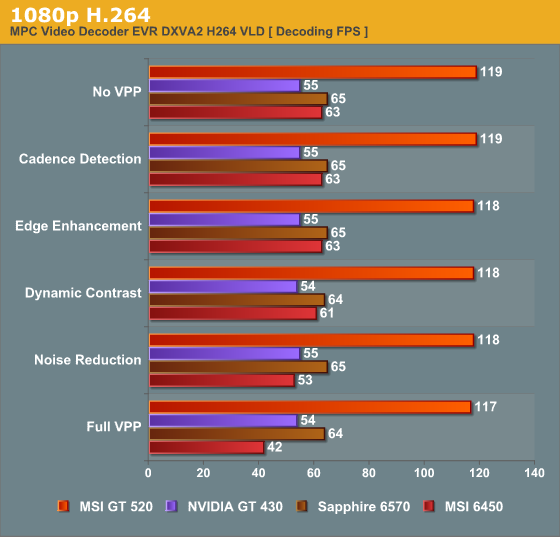
While the GT 430 was unable to reach the magical 60 fps benchmark figure (I expect any GPU worth its salt to be able to decode 1080p60 H264 clips), the GT 520 sprang a surprise with some insane decoding speeds. Even considering the fact that the GT 520 took shortcuts by skimping on the post processing, it comfortably beats every other GPU in the race. The 430's benchmark result was even more puzzling, considering the fact that all the 1080p60 AVCHD and re-encoded broadcast clips that we threw at it played back flawlessly. We talked to NVIDIA about this, and it looks like the culprit in this case was the bitrate. Our sample was a 40 Mbps clip at 1080p30. At 60 fps, the VPU engine would have had to process a sample at 80 Mbps, and apparently, the VP4 engine in the GT 430 is simply not capable of that. We are willing to cut NVIDIA some slack here, because I have personally not seen any real 1080p60 content at 80 Mbps. We will cover both of the above aspects in detail in the next section.
With the exception of the 6450, we find that enabling various post-processing options doesn't bring down the decode frame rate. This shows that the latency of the post processing steps is completely hidden by the time spent in the UVD / VPU engines to obtain the decoded frame. For the 6450, we infer that the lower core clock for the stream processors slows down the post processing steps a bit too much.
For the 1080p VC-1 clip, we again use MPC Video Decoder v1.5.2.3134 for flawless play back.
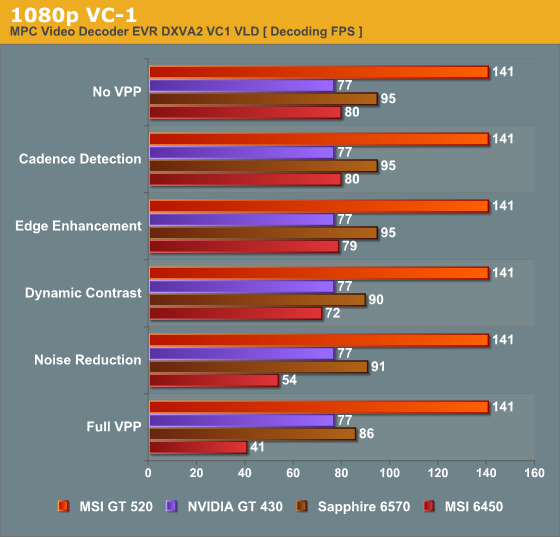
We find that the NVIDIA GPUs hide their post processing latency in the time taken by the VPU engine. However, the 6570 shows a gradual decline in the throughput as various options are enabled. The decline is not as alarming as the 6450's, and manages to comfortably stay above 60 fps.
VLD acceleration for MPEG-2 was only recently introduced in the UVD 3 engine by AMD. The Microsoft DTV-DVD Video Decoder is able to provide DXVA2 acceleration for MPEG-2 clips.
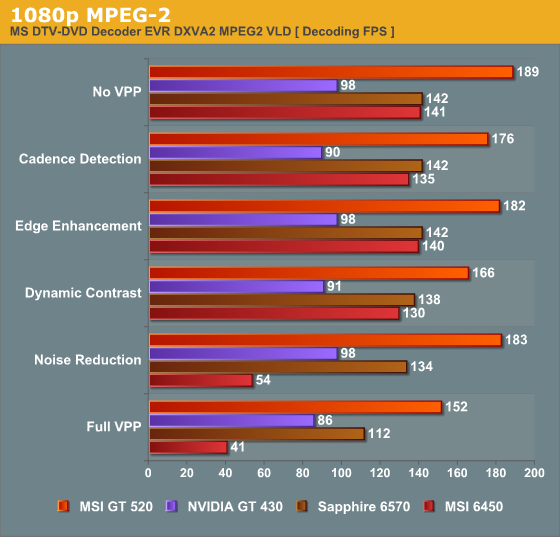
It is not clear why turning on deinterlacing / cadence detection should affect the throughput of the decode of the progressive clip, but that is what we observe for all the candidates except the 6570. Compared to VC-1 and H.264 decoding which decided the throughput of the video pipeline, MPEG-2 is much easier on the UVD / VPU engine. This is reflected in the fact that the video post processing brings down the throughput quite a bit on all the GPUs.
Moving onto interlaced streams, we will consider a 1080i H.264 clip first.

As expected, deinterlacing definitely kicks in to lessen the throughput of the frames. Unlike the 1080p H.264 decode performance, we find that all the GPUs are now limited by how fast the post-processing can be done. This makes sense, since the UVD/VPU engine needs to operate for only half the usual horizontal resolution for interlaced content. Note that the 'frames per second' figure presented for the interlaced streams is actually 'fields per second' (a 1080i clip showing 29.97 fps with MediaInfo actually has 59.94 fields per second).
The interlaced MPEG-2 performance is as below:
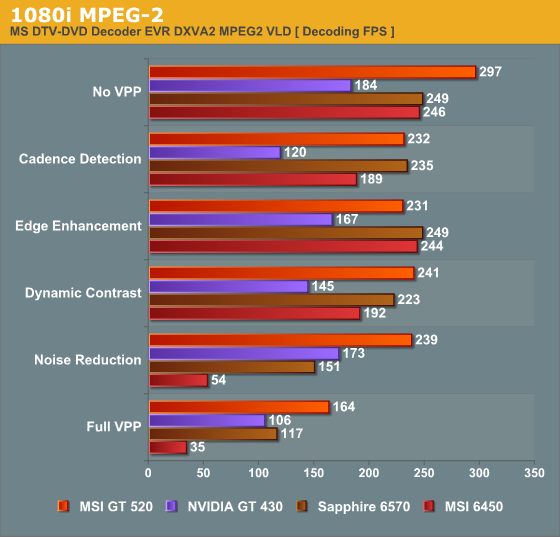
Results are very similar to what we got for the interlaced H.264 clip. One can conclude that interlaced clips spend more time getting post-processed compared to the progressive clips, but that is hardly surprising.
We had noted earlier that DXVA2 / EVR wasn't enabled for interlaced VC-1 streams on any of the GPUs. However, with the checkactivate.dll hack (described in the LAV Splitter section), we were able to make Arcsoft Video Decoder appear in the list of codecs when the 'Check DirectShow / MediaFoundation Decoders' was used for interlaced VC-1 clips. Though it wasn't explicitly indicated that the support was DXVA2 using EVR, we did find that playing back the stream using EVR consumed almost nil CPU resources and kept the GPU / VPU engine quite busy. Presented below is the interlaced VC-1 performance using the Arcsoft Video Decoder in Total Media Theater v5.0.187
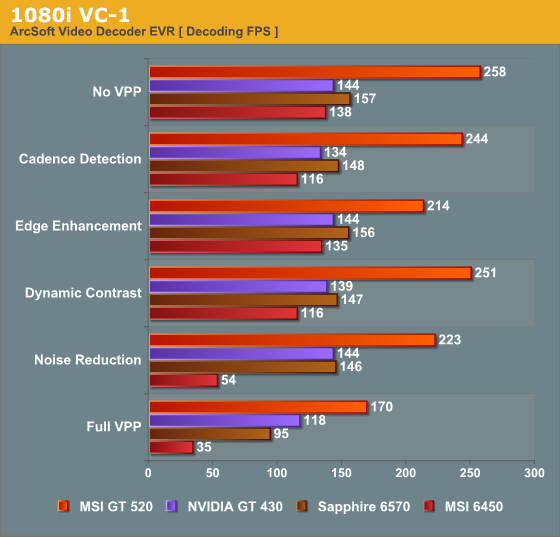
The takeaway from this section is that cards which run too close to the 60 fps limit with all post processing steps enabled should be avoided, unless there are some convincing reasons for that. The results also need to be taken in conjunction with the day-to-day usage experience. As mentioned before, the 6450 fails on both counts. The GT 520 fails the day-to-day usage test (deinterlacing performance). The GT 430 gets a recommendation despite weighing in at less than 60 fps for the 1080p H.264 stress stream. The 6570 is the hands down winner in this section. It is able to carry out all the post processing steps even when it is forced to process very stressful video streams.










70 Comments
View All Comments
casteve - Monday, June 13, 2011 - link
I hope to see a review of the HD 6670, now that (at least) Sapphire has released a passive version.Drae - Monday, June 13, 2011 - link
... it'd be nice to see more use of Linux please. I realise there are a lack of "testing" and "evaluation" tools under Linux but that shouldn't prevent the testing of basic media needs. What's this about no bit streaming support under Linux? Boxee would disagree - as would:http://phoronix.com/forums/showthread.php?27348-Tr...
along with XBMC's audioengine (involving work by the guy in the above link). Maybe Windows 8 will sort out the mess that is WMC and all the messing (or bypassing with MPC-HC) that is required to get it working solidly. But right now if you want something that approaches a plug and play media experience XBMC (and its off-spring Openelec) under Linux is a lot closer than Windows. Equally the more coverage such solutions get the more likely greater time will be spent fixing the remaining issues under the Linux OS - hello there Intel and AMD.
Finally there is a great move now - go look at AVS' fora for examples - away from large media center pc's to small, quiet (silent) systems. These don't require 300W or 500W power supplies and huge cases with twelve fans and fifty million led's. They are ITX based systems sitting in small ITX sized boxes running 65/80/90/120W PicoPSU's with much greater efficiency and thus lower power use/running costs/silence. Placing these discrete cards in such systems would be a nice test of these picopsu units - given the apparently low power draw shown in the articles (something I'm very interested in seeing right now given the poor support of Linux by Intel on Sandybridge - the GT430 would be a good interim solution for me).
TLDR: Please don't limit yourselves to Windows testing and ATX/mATX sized systems when writing HTPC articles
ganeshts - Monday, June 13, 2011 - link
Drae, Thanks for the info and the link.The issue with Linux HTPCs is the fact that there is a semblance of support from only NVIDIA.
Don't get me wrong! I am a huge Linux fan, and always prefer free / open-source software. But, from a video perspective, is there a multi-GPU platform similar to DXVA ? Every vendor has their own flavour (NVIDIA - VDPAU / Intel - VA-API / AMD - XvBA). From the audio side, it looks like the link you mention is the only avenue available for bitstreaming, and that too for NVIDIA GPUs only. I will keep close tabs on what is happening in this area, and when the time is right, I will definitely post a piece on Linux HTPCs, considering one card from each of the vendors.
cjs150 - Tuesday, June 14, 2011 - link
As always it depends on what you want from an HTPC. For me I want to play Blu rays, stream HD movies from file server, watch and record TV and do some web browsing but in total silence (or as close to as possible).For me ITX systems are the way to go using a 150W PICO-pSU but critical is that they have to work with appropriate IR remote (Logitech DiNovo looks interesting)
I am happy to use Linux or Windows but it just has to work
alfredska - Monday, June 13, 2011 - link
This kind of quality review is what made AnandTech a name to remember early on. I'm glad to see such thoroughness and well thought out presentation of information. Looking forward to more reviews by Ganesh.UrQuan3 - Wednesday, June 15, 2011 - link
Agreed, this is an excelent article. I tried cross referencing to the "Zotec Zbox" article from the 9th (I own an E-350) and the earlier benchmarking was useless. I already know the E-350 won't do full processing, but I wanted to know where it sits compared to these platforms that pull 3-10 times the power.Think a 'software mode' might have been useful? An i5 could have done a fair amount of this processing without a hardware assist, saving the 70watts the cards were pulling and avoiding some of the integrated's compatability issues.
Shadowmaster625 - Monday, June 13, 2011 - link
I dont get the video card focus in the realm of HTPC. It seems that software is a far more important piece of the picture than a video card. Windows media center and XBMC both work like crap, and/or are unacceptably slow and clunky when it comes to browsing media. I do NOT tolerate that kind of lag, especially on a 3 ghz quadcore with an ssd/hdd drive setup. I dont expect miracles when trying to browse through a gigabyte of media, but still it should be faster. And then there's audio sync problems that like to appear out of nowhere. But you'd never know any of these problems exist from reading these articles. Shrug.I have found that VLC media player and windows explorer are the most reliable combination. But using windows explorer on an htpc is ugly and painful.
JasonInofuentes - Tuesday, June 14, 2011 - link
I think part of the problem is the degree to which there's news. A thorough review of Media Center might be warranted, the next time it changes, but was pretty thoroughly covered here (http://www.anandtech.com/show/2864/) and here (http://www.anandtech.com/show/2760). XBMC has a more frequent update cycle than Windows, and there's obviously interest so this might be an idea to explore further.As far as the difficulties with each of these platforms, a Z68 platform and SRT might be the solution here. So the size of the files is not really the problem, it's that when you browse to a folder the user wants to be able to scroll around the list or grid and have all of the information pertinent to those files readily available. You don't want to scroll over to a file in your West Wing Season 5 folder and wait for the Title to load so you know whether it's the episode you were looking for, you want that information to be up the instant you scroll to it, or even better for it to be glanceable before you even start scrolling. In order to achieve this the OS's load all of the information for all of the files in the folder. So if you have a few dozen files in a folder that's the metadata for each files, the thumbnail preview and then the usual file system queries the OS would do anytime it accesses the drive. That can add up to a lot of small reads, and that leads to that big stall as you scoot around your media.
Now, the throw money at it solution is move to ALL SSD storage. But I've got 4TB of media and don't have that kind of money to throw at the problem. SRT should help though. If I recall, the metadata and thumbnail files are stored locally in the folder with the files, but since SRT caches the frequently accessed files, then for a system used exclusively for media the only thing that should populate the SSD cache is going to be these small reads that otherwise slow down your system.
I am suddenly overwhelmed with an urge to get my hands on a Z68 to try this out! And you are quite right that VLC and Windows Explorer are the most reliable programs for browsing and playing back media, but the price you pay for pretty is often performance.
vailr - Monday, June 13, 2011 - link
As an exercise in "possibility thinking", I'd be interested in a sub-category of a complete "solar powered" desktop-format PC review. Designed (theoretically) for someone living in a remote area, off the electrical grid, yet still having internet via satellite, cell phone signal, or otherwise connected. Designed for ultra low power consumption, mostly dependent on solar and/or wind power produced on site. Yet maximal possible performance (under such power restrictions) for either: generic gaming desktop PC, and also for a HTPC. Using SSD's and/or laptop HD's for storage, and with an energy sipping CPU (dual-core Atom vs. Intel i330, for example), combined with either: on-CPU chip video or a "PCIe bus only" powered video card, and yet somewhat viable as a gaming PC or as a HTPC.Maybe even qualify for an article in Home Power magazine? http://homepower.com
Penti - Monday, June 13, 2011 - link
Why? Running a 100 W PC of batteries is pretty pointless.Just install FTTH and a powerline if you like to game or do other intensive tasks needing GPU-power, fast cpus or ridiculous amounts of memory (workstation type stuff). It would be the most efficient solution any way. You don't even need any power for any modems. You certainly can run a PC of battery power off grid, but why destroy your work with that. It would be hard to store much electrical power.
Otherwise you would pretty much had to get by with a low-powered laptop. No monitor.
Do the unabomber type guys need any gaming? If so they need to install a good damn power line or at least a diesel-generator. They don't have the money and skills to build energy storage and buy panels thats enough to power a modern home any way.